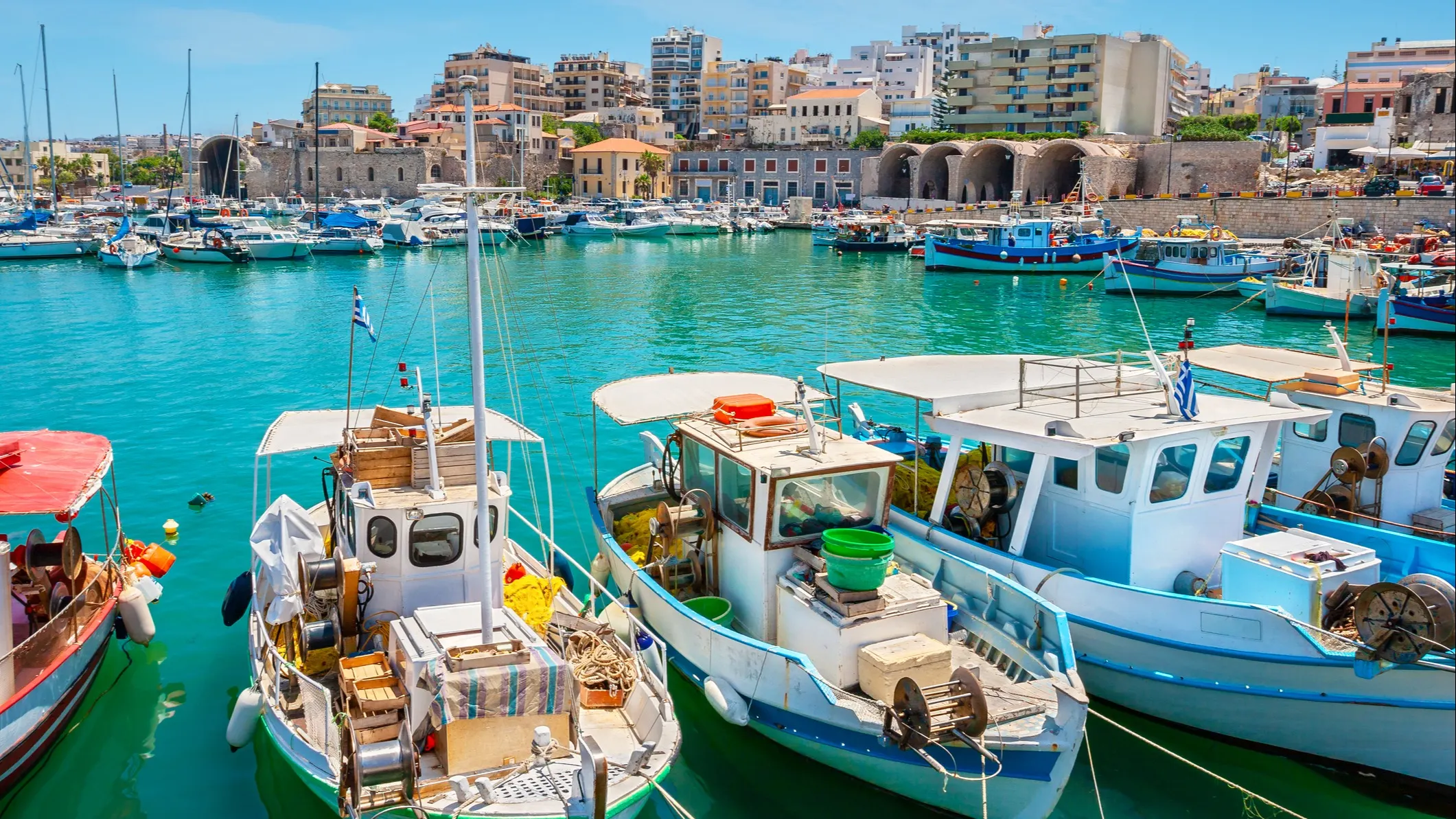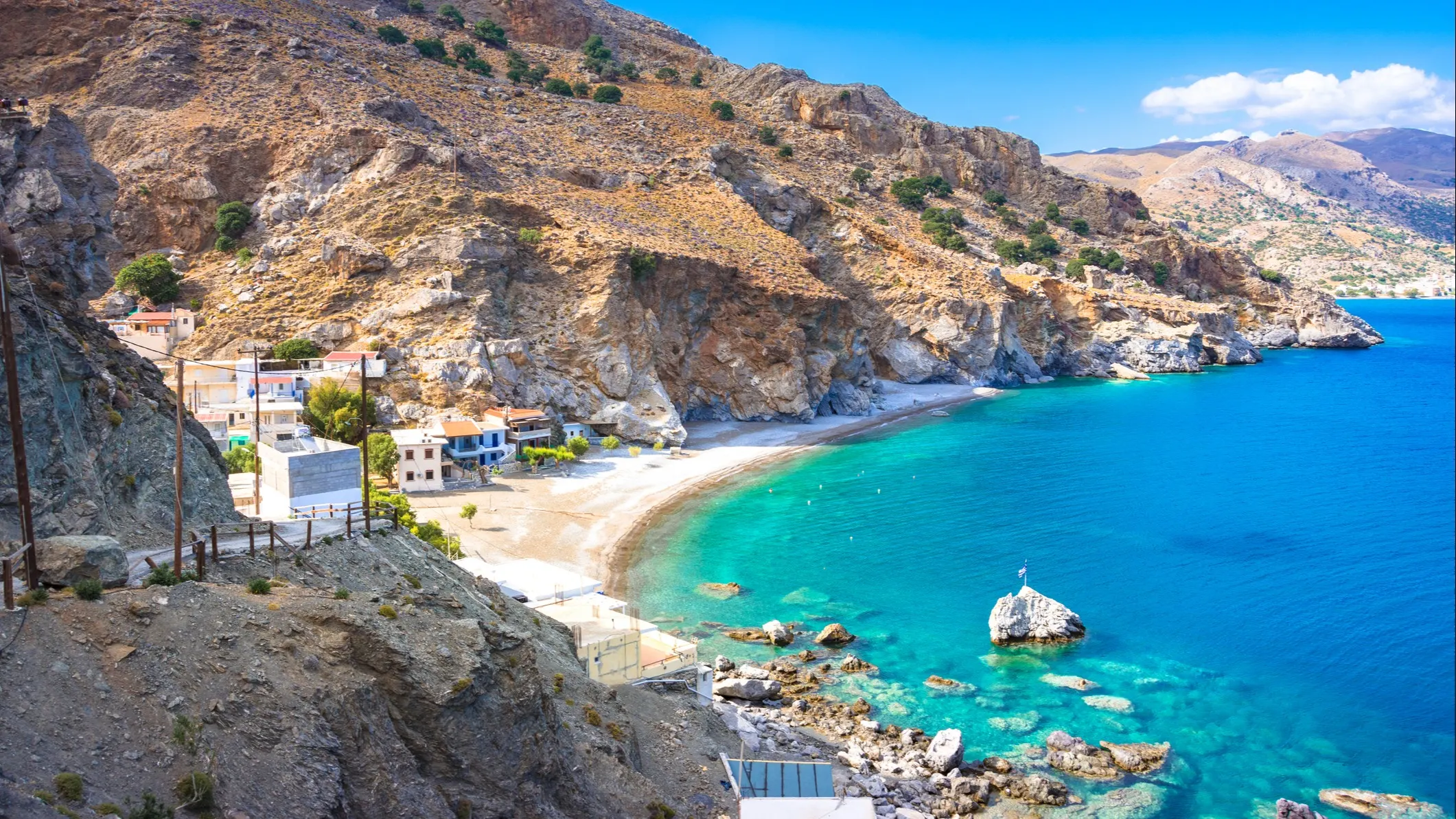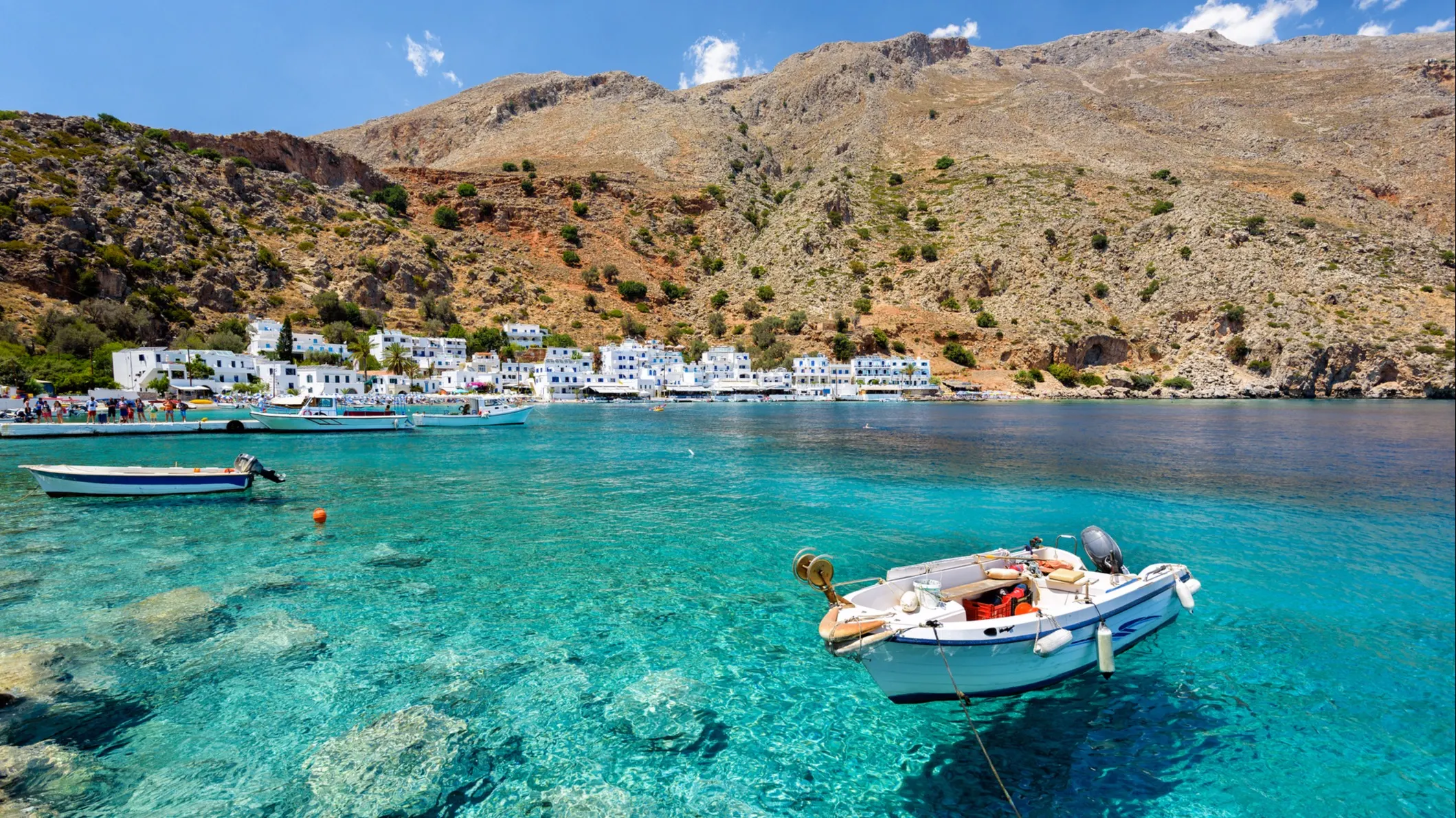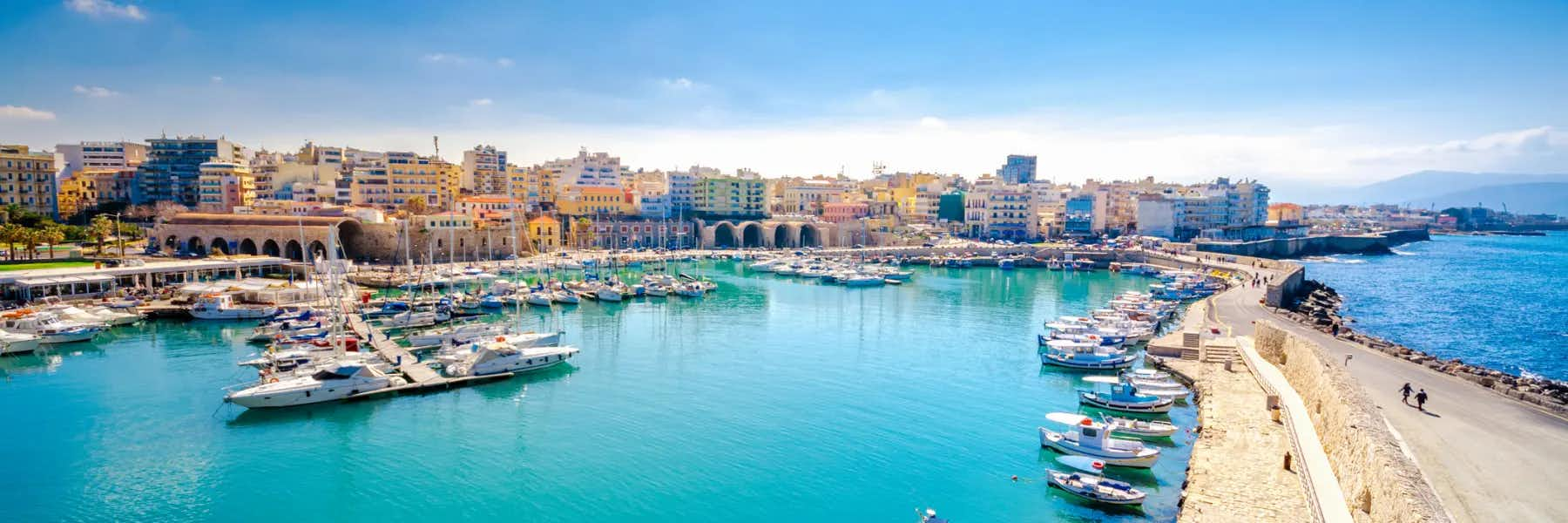If you long to experience ‘the real Greece’, one of your best options is to head to Heraklion, an alluring small city on the island of Crete. Crete is a beautiful, down-to-earth place where you can take full advantage of the sunny, Mediterranean lifestyle. It’s the biggest of the Greek islands: rich in natural beauty, ancient history, and the kind of relaxed ambience and fresh food that makes this part of the world such a sought-after destination. Whether you’re coming for a holiday or thinking about Crete as a long-term expat haven, it’s likely to exceed your expectations…and the welcoming port city of Heraklion is a superb introduction.
Heraklion (also called Iraklio) is a convenient size for exploring, with a population of around 137,000. Amble slowly through town to check out fortresses, cathedrals, churches, and museums, or wander along the shimmering harbor as the aroma of cinnamon wafts invitingly from family-run bakeries. A selection of seafood restaurants and grilled-meat cafes ply their trade in front of relaxing water views, adding to the city’s tranquil character.
Nearby, you’ll find the Minoan Palace of Knossos (a world-renowned archeological site), as well as popular beaches such as Ammoudara, where clear blue waters meet the golden sands of a picturesque bay. In Heraklion’s Old Town, a circuit of defensive stonewalls surrounds pedestrian-only streets interspersed with leafy squares and bustling shops. During the summer months, Heraklion sees a healthy influx of visitors and the nightlife and beach culture really comes alive.
Where is Heraklion?
Heraklion is located along the northern coast of Crete, in Europe’s Aegean Sea. Its central location means that even the most distant corners of the island are less than three to four hours away by car. Whether you explore Crete on an organized tour or choose to rent a vehicle and get around on your own, you’ll find all the best spots within easy reach.
Because it’s the capital of Crete, Heraklion is quite accessible. Its airport is the second busiest in the country and receives year-round flights from Athens and Thessaloniki in Greece and Larnaka in Cyprus, as well as other arrivals during the summer months from a host of other European countries. The flight from Athens is scenic on a clear day and only takes 45 minutes. The airport is about three miles from Heraklion’s city center and taxis are cheap and plentiful.
Ferries between Athens (Port Piraeus) and Heraklion run daily throughout the year, with the trip lasting six to nine hours. From Heraklion, you can also connect to some other Greek Islands by ferry in summer, including Santorini, Mykonos, Milos, Paros, Karpathos, Rhodes, and Kassos.
Crete’s bus system is affordable and convenient, so getting from Heraklion to the most popular attractions around the island is a cinch. If you plan to visit some of the harder-to-reach beaches or villages, hiring a car or motorbike provides more flexibility; just drive carefully and beware of goats crossing the road on hidden mountain curves.
Why Should You Visit Heraklion?

When it comes to living the classic Mediterranean lifestyle, Heraklion has it all: enviable weather, brilliant food, impressive nature, and proud, friendly locals who value family, tradition, socializing, and genuine hospitality. The area in and around the city is steeped in history going back centuries, and the architecture and way of life reflect an eclectic mix of cultural influences.
The climate here is user-friendly: summer brings out the snorkelers, windsurfers, and late-evening diners, and winter is mild enough to keep walkers out and about along the cobblestoned streets and portside promenades. Spring and autumn months are close to perfect, with the kind of mild, sunny weather that makes the rest of Europe jealous.
Heraklion is interesting enough for a month-long exploration, so don’t rush your visit. No matter how long you stick around, you’ll find a good range of places to stay, often with a sea view. Availability can become an issue during July and August when the tourist hordes descend, so it’s wise to book further ahead during the hotter months.
A number of spectacular beaches are within reach of this well-positioned city—it’s an ideal base for assorted seaside adventures. To find your own dream beach, simply drive east or west out of the city and stop wherever the scene grabs your eye. In some spots, a little dirt road driving may be required. There are wilder, less-visited beaches along Crete’s southern coast, so if you want more room to yourself, head down across the island for additional options.
Things to do in Heraklion

Heraklion is blessed with an impressive range of iconic highlights, and is a popular destination for both Greek and overseas tourists. To avoid the crowds and intense summer heat, consider visiting outside the peak summer season—you’ll find the pace more chilled and the prices lower. Here are just a few of the things you can see and do in sunny Heraklion:
The Fortress –
Heraklion’s Koulesis a beautifully restored fortress surrounding the city’s harbor, built by the Venetians in the early 13thcentury. If you want to check it out more closely, visiting hours are 8.30 a.m. to 3 p.m. in winter and 8.30 a.m. to 7 p.m. in summer, every day except Mondays. Cost is around $2.20. The fortress occasionally hosts seasonal concerts and art exhibits, too.
Quality Museums –
Heraklion has a couple of museums you won’t want to pass up. The Historical Museum of Crete houses a nifty collection of paintings, ceramics, coins, and sculptures dating from the Byzantine era up to modern times.
If you’re fascinated by the world of nature, visit the award-winning Natural History Museum of Crete. Housed in an old electrical power plant, it highlights the plants and animals of Crete and the eastern Mediterranean, providing an excellent overview of the region’s natural splendors.
Cathedrals and Churches –
The imposing St. Minas Cathedral was built in 1862 and is one of the biggest in Greece. Its paintings, sculptures, and silver chandeliers are a sight to behold, and the outside, overlooking St. Catherine Square, is just as lovely.
St. Titos Church is much older, dating back to 961 in the Byzantine era. It has been an important Heraklion symbol throughout the centuries and stands guard over attractive Agios Titos Square—a great spot to stop for some Greek coffee, bougatsi(custard pastry), or raki(a potent cousin of ouzo with 40% to 50% alcohol).
Beach Life –
Although Crete’s very best beaches are a fair distance from Heraklion, the long, sandy stretch at Karteros is only five miles to the east and easily reached by local bus. The water isn’t too deep and there are sun beds, beach umbrellas, eating, and drinking facilities available. Further along is Arina beach, where the rocky headland and clear water is ideal for snorkeling.
Further afield, the most delightful beaches on the island include Elafonisi, Preveli, Balos, Matala, Seitan Limania, Kommos, and Falassarna. Turquoise waters, craggy cliff backdrops, and handy tavernasmake visiting Cretan beaches a hedonistic pleasure you’ll never forget. The sea is at its warmest in August.
Cretan Cuisine -
Ask anyone who has traveled extensively around Greece, and they’ll tell you that many of their most delicious meals were enjoyed on Crete. The seafood is fresh, the local meat dishes are divine (if you’ve ever wanted to try roast goat, this is the place), and the markets are brimming with colorful produce. Your local bakery will have all the sweet and savory goodies you could ever desire, at affordable prices. When in Heraklion, try local dishes and wines at every opportunity—you won’t be disappointed. Cretan honey, cheeses, olives, seafood platters, and traditional pies are particularly yummy.
Is Heraklion Safe?

Overall, Heraklion is an extremely safe city to visit, with plenty to see and do, welcoming locals and a more modern vibe than many other Greek cities of similar size. Low-level petty crime does exist, but is rare. Most visitors get around on foot or in a metered taxi and feel quite secure and relaxed.
If you rent a car, be prepared for narrow, winding streets, squeezy parking spots, and distracted pedestrians. If you opt for scooter hire, you must wear a helmet.
Occasional earthquakes and summer forest fires are the only natural hazards that might crop up.
As in all parts of the world, be alert for opportunistic pickpockets in crowded markets and bus stations, and don’t fall for the old ‘Can you tell me the time?’ ploy, where your phone is snatched out of your hand by a fleet-footed thief as soon as you pull it from your pocket.
Visitors to Heraklion (including solo females) will find Heraklion a safe, hassle-free place to explore. As long as normal precautions are observed with personal property, you’ll have no problems enjoying all the best this lively city has to offer. Probably the biggest danger in visiting Crete is that you may never want to leave!
Related Articles
Exploring Chania: Peaceful, Sun-Soaked Bliss on Greece’s Largest Island
Meteora, Greece: Marvelous Monasteries and Otherworldly Geology
Crete and Corfu: For a Healthy, Simple, Greek Island Retirement
